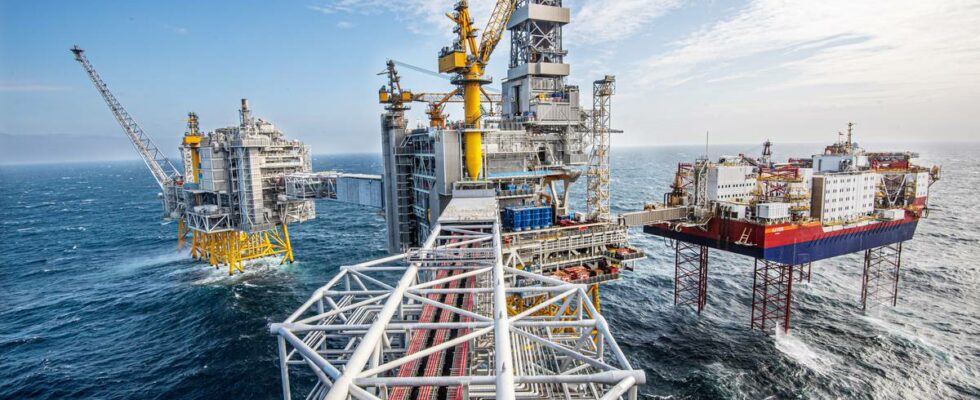Equinor has one of the most ambitious climate targets in the world. By 2050, the company – which today almost exclusively produces oil and gas – has a goal of reducing its net emissions to one figure. Zero. And it does not only apply to emissions from own production (see swipe box). Equinor’s target also includes emissions from the oil and gas when it is burned. Photo: Even Bjøringsøy Johnsen / news So how is the plan actually going? – We are making good progress. The most important thing we do is to reduce our own emissions. They are the ones we are responsible for. We follow the “polluter pays” principle. CEO Anders Opedal says so. He meets news at Fornebu, where he has presented the results for the second quarter. A broad energy company? Equinor wants to become what they call “a broad energy company”. Therefore, in recent years the company has bought into solar and wind, in addition to various hydrogen ventures. But as of today, virtually all of their energy production is still fossil. In 2023, renewables accounted for only 0.4 percent of total energy production. – We have said all along that we have an ambition, and we are focused on having profitable growth. And if we have to choose between profitable growth and achieving the ambition, we always choose profitable growth, says Opedal. Despite an increased focus on renewable and low-carbon solutions, the company will still mainly continue to produce oil and gas. And that means emissions. Cut in own operations Equinor’s emissions can be divided into three different categories. The first two categories, direct and indirect emissions from own operations, are emissions that Equinor has control over. Equinor has managed to cut these emissions by over a quarter since 2015. – It is an important part of our responsibility to ensure that we can produce oil and gas with emissions as low as possible, says Opedal. Until 2030, the company plans to halve emissions from its own operations. But to achieve this, they are completely dependent on land power to electrify the shelf. Something that has turned out to be a politically inflamed issue. Five times as much as Norway But the really big emissions from Equinor’s operations come from the oil and gas that is sold and burned. Today, these emissions are more than five times as much as Norway’s emissions combined. Equinor has an ambition that these emissions should also be net zero. When asked how Equinor intends to reduce these emissions, Opedal replies that in the future they will produce more emission-free power in addition to investing in carbon capture. – Why do they actually count on emissions from end users in your climate ambition? – We are not responsible for category 3 emissions. There are end users who like to release CO₂, Opedal asserts and adds: – But to ensure that we can have a direction for the company and work actively to use the business opportunities that the green shift provides, we have set a ambition that, overall, the carbon intensity, including emissions from end users of the energy we produce, should be lower than it has been in the past. Photo: Marit Hommedal / NTB – Will it be completely zero by 2050? – Yes. That is our ambition. Bad strategy But not everyone believes in Equinor’s ambitions. – Purely ethically, it sounds very good. For the shareholders, I think it is a bad strategy, says equity analyst John Olaisen at ABG Sundal Collier. He believes the market has not believed, and refers to Equinor’s share price recently. UNREALISTIC: John Olaisen, who is a stock analyst at ABG Sundal Collier, is not a “fan” of Equinor’s climate goals. Photo: Marie Gjerver Aftenposten wrote earlier in July about how the Equinor share is doing worse this year than other oil companies that have less ambitious climate targets. Olaisen receives support from colleague Teodor Sveen-Nilsen at Sparebank 1 Markets. He believes that it is only a matter of time before Equinor is forced to adjust down the level of ambition for its climate targets. – We are sure that they are forced to adjust the level of ambition down. I have no idea when that will happen, but it has to come down, he says. Several people in the environmental movement have also been critical of Equinor’s climate goals. Deputy owner of the Norwegian Climate Foundation, Anne Jortveit, has previously criticized the company for lacking credible answers on how to cut emissions from end users. Still high emissions in 2030 Despite the fact that Equinor will increase the share of renewables in the coming years, emissions will still be high in the coming years. Equinor estimates that they will produce as much oil and gas in 2030 as today. This amounts to more than five times as much as the total emissions in Norway today. – How much oil and gas will they produce in 2050? – We do not have any forecasts, but the former CEO said a number of years ago that we expect production in 2050 to be half of what it was then, answers Anders Opedal. – Do you believe that they will reach the goal? – Time will tell. Hello! Do you have any tips for what I should write about? I am generally interested in artificial intelligence, politics, economics and energy. Feel free to send me an e-mail or a message on Signal +47 917 44 070. Published 26/07/2024, at 16.27
ttn-69
Equinor advertises that they will cut emissions to Norway by five times – news Norway – Overview of news from different parts of the country

